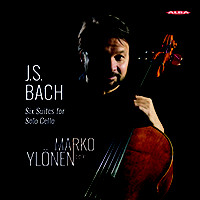
Marko Ylönen. Bach Cello Suites. CD ALBA ABCD444 1-2
Released 2019. Recorded Nov 2016 and May 2017. Venue Kaustinen Church
Cello by Bartolomeo Cristofori. Bow by Pierre Simon 1855.
The Cellist.
Marko Ylönen hails from Finland and has a career spanning the not unusual mix of soloist, chamber, teaching, and director of various festivals. He has included many works by modern Finnish composers in his repertoire which again comes as no surprise given the rarity of top-notch cellists from Finland. That is not meant to be derogatory, it’s just that the country has a population of only 5.5million! Scale that up to the Uk population of 70m then we should have 12-14 top cellists! I’ll leave it to the reader to see if you can think of that number of homegrown international cellists in the UK!
Ylönen has won a Tchaikovsky competition prize in 1996 and many other less familiar competitions. He has given concerts extensively on the international stage. Heinrich Schiff is one of his better-known teachers.
The Recording.
This is a recording that I auditioned firstly on a streaming service. I then bought on CD as the quality appeared very high.
Sitting back and listening to the CD, this impression is affirmed. In fact, I was so caught up in the music and the sound of the cello that I sat there without making notes! I have now listened on three occasions and enjoyed each time.
The recording is in a very spacious acoustic with a fine sounding cello. There is an even spread of tone from top to bottom. A wide sound stage and placement not too forward fills the listening room well. There is minimal extraneous noise.
The music.
This is a recording I would judge to be modern hybrid. It is played with what appears to be a modern set up. The performer has a light airy touch, plenty of articulation, and no obvious vibrato. However, in contrast he plays with glorious legato in the Sarabandes especially. Refreshingly, there is minimal forcing of lower notes and a sense that the tone is lifted out of the cello rather than gouged out.
Slower
On to the interpretation. From the off, this performance grips me. It has all the qualities I look for, namely, rhythm style poise and a sense of progression. Then by means of contrast the Sarabandes are played on the slow side. but no sense of plodding along. There is the smoothness of long legato phrases but interspersed with very precise step like shorter phrases. I’m not prone to visions but I easily imagined dancers of Bach’s period dancing to these interpretations. I am able to imagine the style and aplomb we associate with this time.
Faster.
Faster movements are very well articulated with economical bowing. This avoids the unwieldy “sawing” effect that we can hear in some performances. The third gigue with its double-stopping sections is often where it can all seem to become a bit ragged, but Ylönen is entirely in control. He seems to have a rather neat way of ending phrases with a short but significant rallentando before moving onto the next phrase. This remains within the pulse of the movement so to my ears feels entirely correct.
Throughout the recording the performer employs significant dynamics but very tastefully in my view. It adds interest rather than elevate eyebrows! He uses this to provide variety in repeats which is noticeable and particularly to contrast the fifth movement of each Suite. Most of the Suites in a major key have a second dance in a related minor key and visa versa. Ylönen emphasises this very well which again holds the interest.
A Reservation.
By the time I had reached the sixth Suite I was thinking this recording would merit inclusion in my top five. Unfortunately, I have to say that the Prelude was slightly underwhelming. I did think there might be more attack with the opening cross string section. It is still played very well. However, in the accompanying notes the performer himself alluded to a spirit of celebration with this Suite relating to Christ’s birth. I expected a bit more than I heard! The subsequent movements being a little restrained as well added to this view. I would be surprised if technical limits were contributing, as intonation and bow control seems top notch from beginning to end.
The notes themselves deserve a special mention. They introduce the concept of Aristotle’s Rhetoric discourse. What I understand from my reading is that in communication there are three components. These are logos the logic and reasoning, pathos, the emotional dimension and ethos, the character and credibility of the speaker or performer. This is only a gross simplification of the theory, but it struck me as being exactly how subconsciously or even consciously we take on board any performance of music and particularly the Cello Suites. There is always the technical side, there is always the emotional side and less obviously there is the extent to which a performer displays themselves in a recording. My friend Mark tends to refer to this as less Bach and more ******* where the gap is a particularly idiosyncratic or showy performer.
Conclusion.
This is therefore a recording I highly recommend with the proviso about the sixth Suite. Whilst it may not make the top five, it is certainly a recording I would want to keep when my wife finally has had enough and insists on my shedding some of the almost 100 recordings I now possess!
Charles.